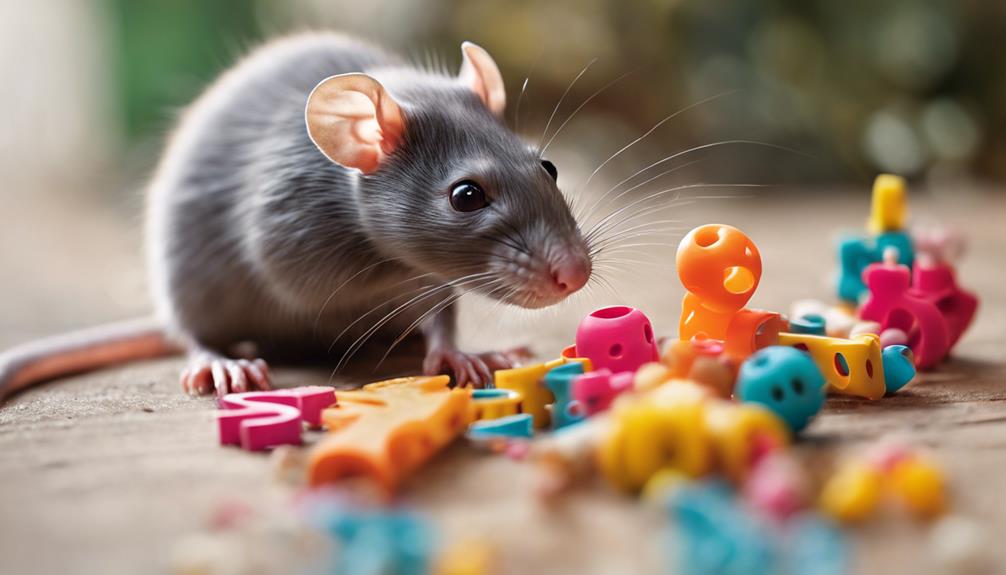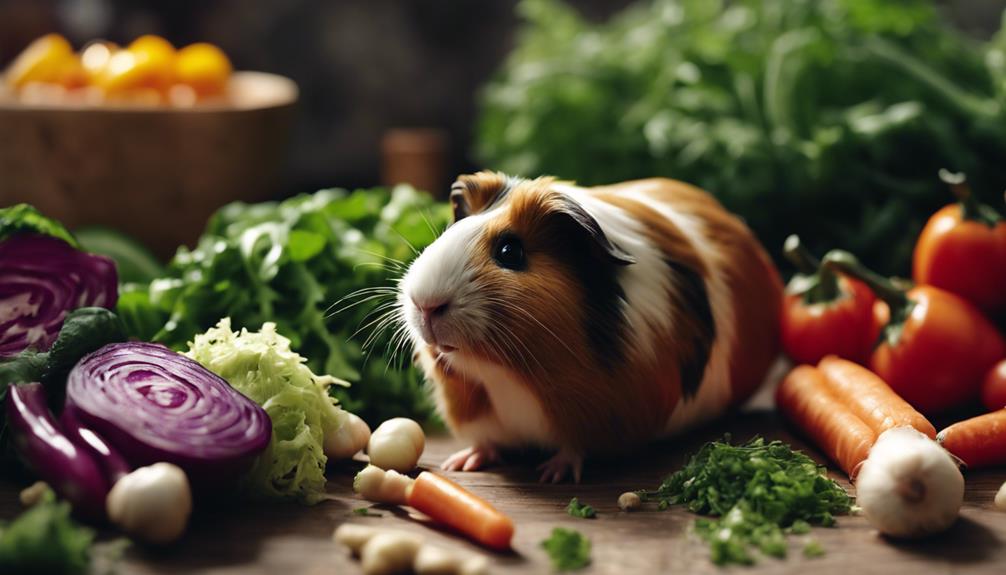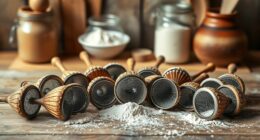Bird lovers consider homemade foraging toys a vital component in keeping their feathered friends engaged and entertained. These toys not only provide mental stimulation, but also help mimic natural instincts and encourage physical activity. When making DIY toys, it’s recommended to use everyday items like paper plates and cardboard, as well as sensory elements like mahogany pods. From simple trays to complex setups with hidden treats, there are endless design possibilities to keep your bird entertained. It’s important to introduce toys gradually to prevent overwhelming your bird, and also to rotate toys regularly to maintain their interest. Safety precautions should be taken to avoid choking hazards and to monitor playtime. Enhance the foraging experience by incorporating different textures and colorful designs. Explore various toy options to learn more about how you can enrich your bird’s life.
Key Takeaways
- Homemade foraging toys provide mental stimulation and mimic natural instincts.
- Use common household items like paper plates, cardboard, and natural materials.
- Create engaging designs with grooves, challenges, and colorful elements.
- Introduce toys gradually, rotate regularly, and monitor interactions for safety.
- Ensure safety by avoiding small parts, using non-toxic materials, and regular inspection.
Benefits of Homemade Foraging Toys
Homemade foraging toys offer bird owners a cost-effective and customizable way to provide mental stimulation and enrichment for their feathered friends. Birds absolutely love the challenge of foraging for their food, mimicking their natural instincts in the wild. By engaging in this activity, birds not only stay physically active but also exercise their minds, preventing boredom and negative behaviors. These toys provide a sense of accomplishment for your bird, as they successfully navigate the puzzle to find their treats.
Bird owners always ask how they can keep their pets entertained and happy, and homemade foraging toys are a fantastic solution. You can tailor these toys to suit your bird's preferences and abilities, ensuring that they're always engaged and stimulated.
With just a little bit of creativity and some basic materials, you can create an enriching environment for your feathered companion. Homemade foraging toys aren't only fun for your bird but also environmentally friendly and cost-effective compared to store-bought options.
Materials for DIY Creations

Using common household items and natural materials, you can easily create engaging DIY foraging toys for your feathered companion. Materials like paper plates, cardboard pieces, paper straws, cork buttons, lolly sticks, and rattan balls are excellent choices.
Incorporating natural elements such as mahogany pods, corn halves, and dried grasses like flax and sorghum can add variety and sensory stimulation to your bird's foraging experience. Repurposing egg cartons into foraging trays with compartments filled with treats or seeds can increase the complexity of the activity.
To enhance your bird's foraging experience, consider incorporating grooves in the trays for items like eggs, broken toy parts, rat handballs, and finger traps. Additionally, using cupcake cases for treats, corn husks, loofah, straws, and a mix of broken toy parts can make foraging more engaging and stimulating for expert foragers.
Types of Foraging Toy Designs

To explore various engaging designs for foraging toys, consider incorporating different materials and features that cater to your bird's natural instincts and encourage mental stimulation. Foraging toy designs can range from simple DIY trays made with paper plates and cupcake cases to more complex trays using egg cartons for added challenge.
Features like grooves for eggs, broken toy parts, and a variety of colorful items make foraging toys engaging and stimulating for birds. Innovative ideas include incorporating corn husks, loofah, straws, and broken toy parts to add complexity and fun to the foraging experience.
By combining different tray ideas, you can encourage birds to engage in creative foraging behaviors, stimulating their natural instincts while providing mental and physical enrichment. These toys offer numerous benefits by promoting problem-solving skills, physical activity, and overall well-being for your feathered friends.
Experimenting with various designs can keep your bird entertained and mentally engaged while satisfying their innate foraging needs.
Step-by-Step Assembly Instructions
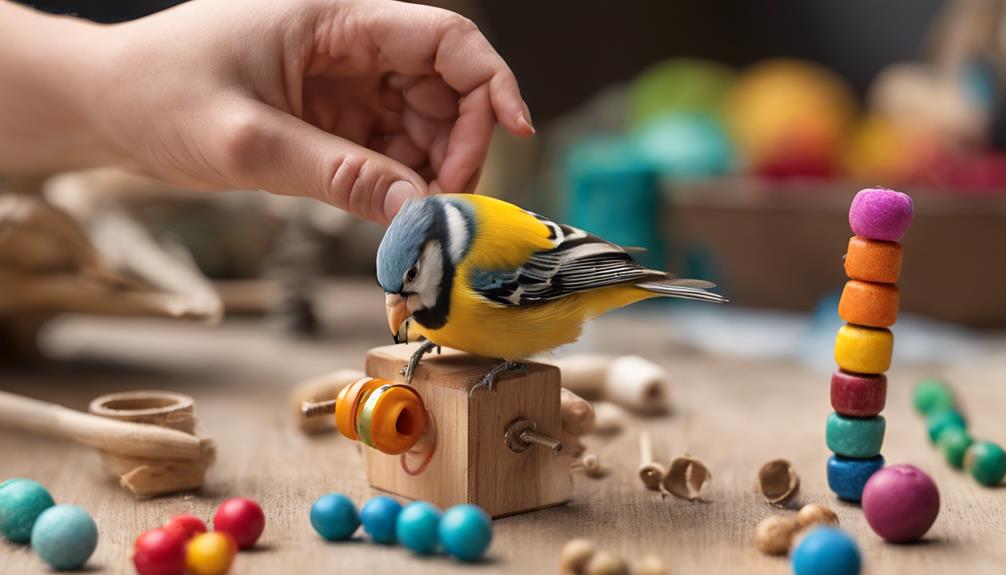
To assemble your homemade foraging toy, begin by choosing the right materials like paper plates and cardboard pieces. Utilize assembly techniques such as creating compartments with egg cartons for added complexity.
Follow these steps to guarantee a stimulating and safe foraging experience for your feathered companions.
Toy Material Selection
Consider carefully selecting materials for homemade foraging toys to guarantee the safety and enjoyment of your bird companion. Opt for safe and bird-friendly options like untreated wood, paper, cardboard, and natural fibers. These materials are non-toxic and won't harm your bird if ingested.
Avoid toxic paints, glues, plastics, or small parts that could be swallowed and pose a choking hazard. Choose items that can be easily manipulated by birds, such as shreddable paper, foraging cups, or compartments for hiding treats.
Incorporating a variety of textures and colors will engage your bird's senses and simulate their natural foraging experiences in the wild. Additionally, provide a mix of challenges and interactive elements in the toy design to keep your feathered friend mentally stimulated and physically active during playtime.
Assembly Techniques
Begin by selecting a sturdy base, such as a paper plate or plastic serving tray, for your homemade foraging toy. Cut up plain white paper or crinkle paper into small pieces to fill the base, creating a textured surface for your bird to forage through.
Next, add a variety of items like paper straws, cardboard pieces, cork buttons, and natural materials to keep your feathered friend engaged and entertained. Incorporate challenges by hiding treats or seeds in different compartments, like using an egg carton tray with multiple sections for added complexity.
Remember to prioritize the safety of your bird by ensuring all materials used are bird-friendly and non-toxic. By following these assembly techniques, you can create a stimulating and enjoyable foraging experience for your pet bird while promoting their natural instincts and mental stimulation.
Tips for Introducing Toys to Birds

When introducing toys to your bird, remember to start slow to avoid overwhelming them. Choose toys that are suitable for your bird's size, species, and personality for a positive play experience.
Toy Selection Tips
To successfully introduce toys to your bird, start by gradually presenting them one at a time to prevent overwhelming your feathered friend. This approach allows your bird to adjust to each new toy and prevents stress. Rotate toys regularly to keep your bird engaged and interested, as this prevents boredom and encourages exploration.
Offering a variety of textures, colors, and shapes stimulates your bird's senses, providing mental and physical enrichment. Monitoring your bird's interactions with toys is essential to guarantee safety and enjoyment. Pay attention to how your bird plays with each toy and remove any damaged or potentially hazardous items promptly.
When selecting new toys, consider your bird's preferences and behavior. Different birds have varying interests, so observe what types of toys your bird enjoys the most. Tailoring toy selection to your bird's preferences can increase engagement and playtime.
Encouraging Play Behavior
To guarantee the safety of your bird, introducing toys gradually can help them feel more comfortable and engaged with their new playthings. To promote play behavior, use positive reinforcement such as treats or praise when your bird interacts with and explores the toys. It is crucial to rotate toys regularly to prevent boredom and keep your bird mentally stimulated. Observing your bird's preferences and play style will help you select toys that cater to their interests and needs. Always make sure that the toys you provide are safe, durable, and appropriate for your bird's species and size to avoid accidents or ingestion of harmful materials.
| Tips for Encouraging Play Behavior |
|---|
| 1. Introduce toys gradually to avoid overwhelming your bird. |
| 2. Use positive reinforcement like treats or praise. |
| 3. Rotate toys regularly to keep your bird engaged. |
| 4. Observe your bird's preferences and play style. |
| 5. Make sure toys are safe, durable, and suitable for your bird. |
Safety Considerations for Homemade Toys
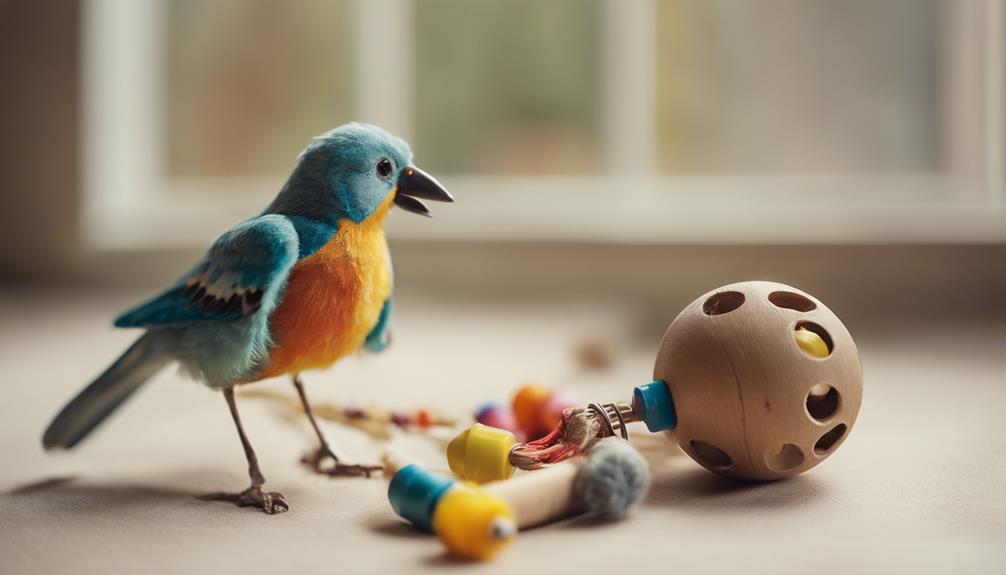
Make sure that homemade bird toys are free from potential choking hazards, toxic materials, and securely attached components to prioritize your bird's safety during playtime. Check for any small parts or loose strings that could pose a choking risk.
Toxic materials like glue, paint, or certain types of wood should be avoided to prevent harm if ingested. Confirm all toy components are firmly attached to prevent accidental ingestion or entanglement.
It's important to monitor your bird while they play with homemade toys to ensure they're using them safely. Regularly inspect these toys for wear and tear, replacing them if they become damaged to prevent any potential injuries.
Enhancing Foraging Experience With Variations

Enhance your bird's foraging experience by incorporating a variety of materials and challenges into their foraging trays. Customizing these trays with a mix of paper straws, cardboard pieces, and lolly sticks allows you to cater to your bird's individual preferences.
By adding natural elements like dried grasses, mahogany pods, and corn halves, you can create a more engaging foraging experience that mimics the wild.
For a mental challenge, utilize complex foraging trays with compartments such as egg cartons to keep your bird entertained and stimulated during foraging sessions.
Expert foragers may benefit from the inclusion of broken toy parts, finger traps, and rat handballs in their trays, providing interactive and challenging activities.
To keep things visually interesting, enhance your bird's foraging trays with colorful and multifaceted designs, including grooves for eggs, ensuring a continuous level of engagement throughout the foraging process.
Frequently Asked Questions
What Are the Home Made Bird Foraging Toys?
Home made bird foraging toys are DIY creations that stimulate your bird's natural instincts. You can craft these toys from everyday materials like paper, cardboard, and straws to provide mental and physical enrichment, tailored to your bird's preferences.
Why Do Birds Need Foraging Toys?
Birds need foraging toys as they provide mental stimulation, prevent boredom, and replicate natural foraging behaviors. These toys improve problem-solving skills, physical activity, and overall well-being, reducing stress and preventing behavioral issues in pet birds.
Can a Bird Cage Have Too Many Toys?
You can overcrowd a bird cage with too many toys, limiting your bird's freedom of movement. Provide a variety of safe toys for mental stimulation but avoid overwhelming them. Rotate toys to keep your bird engaged and monitor their behavior.
What Household Items Can Birds Play With?
You can jazz up your bird's playtime with simple household items like paper cups, paper towel rolls, and cardboard boxes. These inexpensive options offer mental stimulation and entertainment, keeping your feathered friend happy and engaged.
Conclusion
To sum up, homemade foraging toys aren't only a fun and engaging way to keep your bird entertained, but they also provide important mental and physical stimulation.
By using a variety of materials and designs, you can create a stimulating environment for your feathered friend.
Remember to prioritize safety and introduce toys gradually to guarantee a positive experience.
So get crafting and watch your bird soar with excitement as they explore their new toys!


